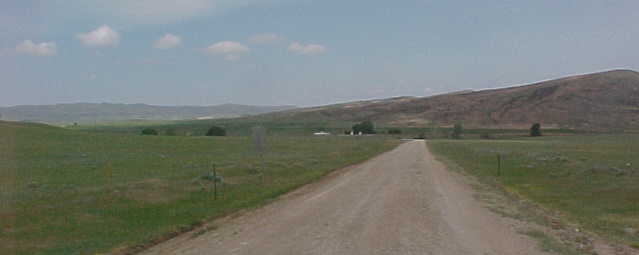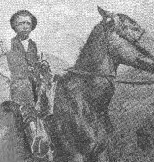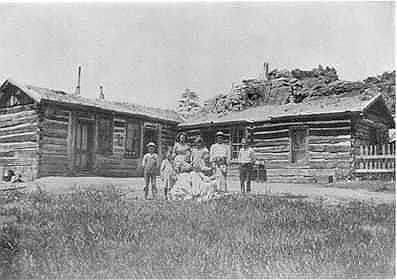
Scene near Iron Mountain Post Office (Farthing, Wyo.), June 2001, photo by Geoff Dobson
Seven miles from Iron Mountain was the ranch of Kels Nickell, the only sheepherder
in the area. On July 18, 1901, Nickell's 14-year old son, Willie was shot and
killed by two bullets in the back. At the time Willie, tall for his age, was
wearing his father's coat and hat and was riding his father's favorite horse.
It is generally believed that the killer mistook Willie for Kels. Based upon blood at the scene, it was apparent
that Willie had fallen face down, and that someone had turned the body over and placed
a stone under Willie's head. The culprit left no footprints or shells at the
scene.

Distant view of area in which Willie Nickell was shot. Photo by
G. W. Walker, Cheyenne, 1902. 1. marks the area where shooter lay in ambush; 2. The area of the gate where Willie
was shot; 3. the area in which Willie's body was found. For an indication of scale the distance from
the hiding place, 1, to the gate. 2, was approximately 300 yards.
Seventeen days later someone shot Kels, wounding him in the arm, hip,
and side. While Kels was in the hospital, masked men clubbed a number of Kels'
sheep to death. Shortly thereafter the Nickell family moved to Saratoga.
 William "Willie" Nickell, 1901
Victor Miller, a neighbor who was involved in a feud with Kels over the
sheep in cattle country,
was initially suspected of the crime. Ultimately
suspicion turned to Tom Horn because of Horn's involvement in prior killings. In October, 1901,
Horn was in Denver staying at the Windsor Hotel on the corner of Larimer and 18th. At one time,
the Windsor was the finest hotel in the City, but it had been supplanted by Henry C. Brown's Palace.
After Horace Tabor lost his fortune, he lived (and died) in a room at the Windsor.
Brown constructed the Brown Palace after he had been refused service in the Windsor dining
room. Brown vowed that he would outdo and outlast the Windsor. The Brown Palace is still
Denver's snootiest hotel. The Windsor was torn down in the 1960's. In Denver, Horn went on
a binge in the LoDo Section of Denver. Among the establishments he visited was the Scandinavian House Saloon at 1719 Blake Street,
two blocks southeast
of the present site of Coors Field. The saloon, an iron-fronted store-front establishment with its name painted on the
windows and the name of the proprietor on the awning, advertised Coors Beer. Within the saloon,
Horn, while drunk, bragged to Frank Mullock and Robert C. Cousely that he was at the center of the Willie Nickell case and
admitted that he fired the shot. The site of the Scandinavian is now a parking lot.
At the Windsor, Horn was found in his room, passed out, with
a broken jaw that he apparently received in a fight he picked with a professional
boxer at Pennington's Saloon on Larimer Street.

Nickell Homesead, Iron Mountain, photo courtesy of Margie McDonald Schrey.
In Cheyenne, after Horn recovered from his injuries, Deputy U. S. Marshal Joe LeFors invited Horn
to meet with him on the basis that he, LeFors, had a friend in Montana who needed
some "secret" work done by someone who was not known in the area. Specifically,
it was suggested that there was a "gang" which needed to be infiltrated. It was
proposed that someone was needed who would act as a "wolfer" and would be
accepted into the gang.
On Saturday, January 11, 1902, Horn met with LeFors in his office on the second floor of the Commercial
Block, 16th Street, in Cheyenne and the two engaged in conversation. Unbeknownst to
Horn, two witnesses were secreted in the next room: a short hand stenographer,
Charles Olnhaus, and Laramie County Deputy Sheriff, Leslie Snow. Olnhaus would later serve as
Clerk of the United States District Court.

16th Street, Cheyenne, c. 1902
The office is the one with the second-floor
bow window on the left in the above photo. See next photo. At the end of the block on the
same side of the street is the
Inter-Ocean Hotel with the front canopy extending over the sidewalk. The three-story
building, with the bow windows on the second and third floors on the right-hand side of the
photo is the Atlas Building at 211 W. 16th Street.

Center bow window is that of the U.S. Marshal's office. c. 1902. Photo
appears to have been taken from the second floor of the Atlas Building.
During the course
of conversations over two days, Horn allegedly admitted that he killed Nickell with his
Winchester Model 1894 30-30 rifle and placed a stone under Nickell's head as his "sign." Horn told
LeFors that he, Horn, had been paid in advance and received $2,100 for killing three men and taking
five shots at another. He told LeFors that the reason there were no
footprints is that he was barefoot. LeFors asked whether Horn had carried the shells
away, to which Horn responded: "You bet your [expletive deleted] life I did."
Additionally, Horn admitted to the unsolved murder of William Lewis and Fred Powell near Iron
Mountain in 1895. On Monday, January 13, Horn was arrested in the bar of the Inter-Ocean
Hotel by Laramie County Sheriff Edwin J. Smalley, accompanied
by Deputy Sheriff Richard A. Proctor and Chyenne Chief of Police Sandy McNeil.
Deputy United States Marshal Joe LeFors watched.
Left, Joe LeFors; Right, Sheriff Edwin J. Smalley
John Coble paid for Horn's defense, with Horn being represented by the general
counsel for the Union Pacific, John W. Lacey, formerly a Wyoming Supreme Court justice.
The exact employment relationship of Horn to the Iron Mountain spread
or to Coble is, however, uncertain. The ranch
foreman, Duncan Clark testified, after Willie Nickell was killed, that Coble was east in
Pennsylvania at the time. Clark could not say whether Horn worked for
Coble because Horn "just comes in and goes out." In response to a direct question of
whether Clark knew where Horn came from when he rode in two days following the killing, he
responded: "No, sir, he never tells me and I never ask him.
I never expect to get the truth anyway." At the time Horn was riding a T Lazy Y horse,
a brand still in use in the Chugwater area.
Motion pictures have attempted to make it appear that there was considerable
doubt as to Horn's guilt. The films focused on the question of whether
Joe LeFors got Horn drunk and whether Horn had really confessed or if the shorthand stenographer
Charles Ohnhaus had misheard or mistranscribed Horn's statement.
 John C. Coble
John C. Coble
The defense was three-fold: (1.)
Horn was under the influence of liquor, tended to make things up, and became talkative
when drunk. Witnesses were produced that Horn had been drinking. He denied making the statements in the
Scandinavian. He contended that his jaw had already been broken when he was in the
Scandinavian and with the cast he could not talk. (2.) Horn had an alibi
and could not have been in the Nickell ranch at the time of
the killing. He was in Laramie City, as proven by the fact that Horn's horse, Pacer,
was lodged at the Elkhorn Livery in Laramie City for a ten-day period at the time of
the killing. Witnesses testified that Horn was nowhere near the Nickell Ranch at
the time of the slaying. (3.) The killing could not have occurred as he
described to LeFors in the following regards: (a.) Dr. Amos Barber testified, based on learned texts, that
the wounds could not have been inflicted with a 30-30 similar to Horn's. (b.)
Frank Stone had bunked with Horn several days later and had observed
no injury to Horn's feet such as would have been produced had Horn gone barefoot. One of Horn's
lawyers testified to having examined the area of the Nickell gate where the killing took place. He
testified that the area was strewn with cacti and rocks such that no one could go barefoot
in the area. Samples of the rocks were introduced into evidence. (c.)
Horn, in his statement to LeFors, described the shooting as coming from one direction.
The fatal shot came from another.
 Tom Horn, compare with photo on next page.
Tom Horn, compare with photo on next page.
Horn took the stand in his own defense. The cross-examination by the prosecutor, Walter
Stoll, was devasting.
Statement by statement, Horn admitted making the various statements testified to
by LeFors, Snow and Ohnhaus with
the exception of one statement which Horn did not remember but conceded he might
have made. Stoll asked Horn relating to some alleged statements made in Denver:
Q. At that time, I am not asking to reflect on you in anyway, were you in a condition to
remember whether you had these conversations with these men or not?
A. I remember everthing that occurred to me in my life.
Q. You have never been so much under the influence of liquor as to not remember what you
said?
A. Not if I could talk.
Yet, in addition to the statement he could not remember, time and time again, Horn could not
remember things:
Q. Did you have on your straw hat in riding from Coble's ranch down to Laramie City on July 20th, or do you
remember how you were dressed?
A. I don't remember.
Q. You do remember distinctly that you did not see anyone on the way down?
A. I don't remember distinctly that I didn't see anyone; I don't remember of seeing anyone.
Witnesses had testified that they saw Horn on the road to Laramie City.
Horn contended that his
confession was a "josh;" it was merely
an exchange of wild tales. Slowly and inexorably through a plethora of witnesses, Stoll destroyed
Horn's defenses and alibis. 1901 Frontier Day Bronco Champion 24-year old Otto Plaga testified that an hour
after the time of the killing,
Horn was 17 or 18 miles miles from the Nickell Ranch. Horn destroyed this alibi by admitting that he could easily have made it
to where Plaga said he was following the killing. The witnesses admitted that although Horn had been
drinking, Horn was in control of himself. Dr. Barber admitted he could not say that
the wounds were not inflicted with a 30-30.
Other alibi witnesses placed Horn in a different
location from that where Horn said he was. And yet others placed
Horn at the Miller Ranch 3 or 4 miles from the Nickell Ranch for several days before the
killing and at the William Clay Ranch just to the north of the Nickell
spread. The owner of the Elkhorn Barn admitted that the time of check-in of Pacer at the livery in
Laramie City was filled out on the registration form when Horn checked out. Horn could have made it to
Laramie City following the killing. Various witnesses testified that Horn's horse was in a lather, covered with sweat, as
if ridden hard. Further doubt as to the "Pacer" defense was created by testimony that in addition to Pacer Horn was
also riding a CAP brand horse named "Cap." Witnesses were adduced that Horn left
a sweater in a shoe store in Laramie City which was covered with dirt. The owner and the clerk were
so sure that the individual leaving the sweater was Horn that they mailed it to
Horn at the Laramie County Jail care-of Sheriff Smalley.
At the conclusion of the two-week trial, on October 24, 1902, at
4:20 p.m., the jury foreman called to the bailiff telling him that the jury
had reached a verdict. Seventeen minutes later, with the jury in the box, the verdict was read.

Elkhorn Livery, Laramie City, where Pacer was
lodged
Next Page: The verdict and appeal, postscript.
|